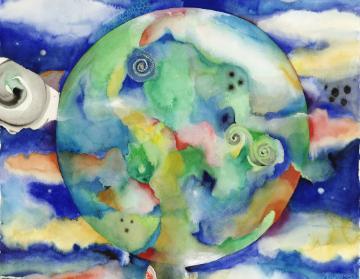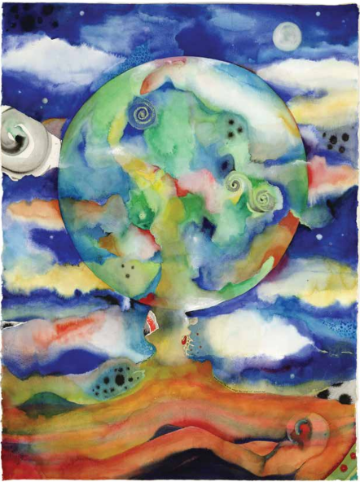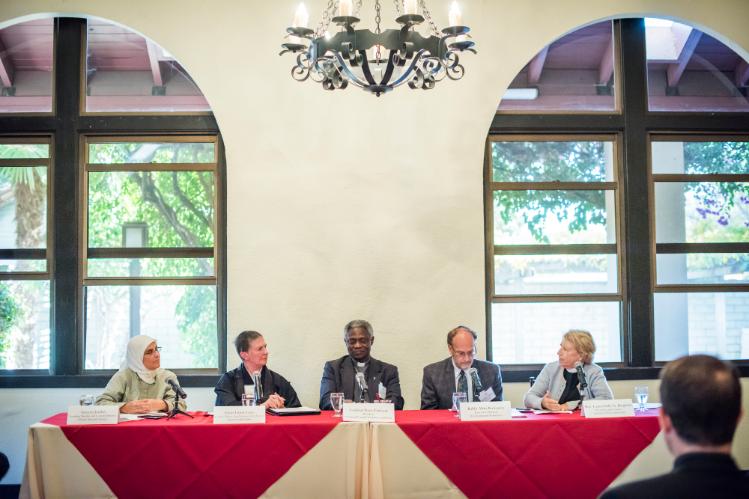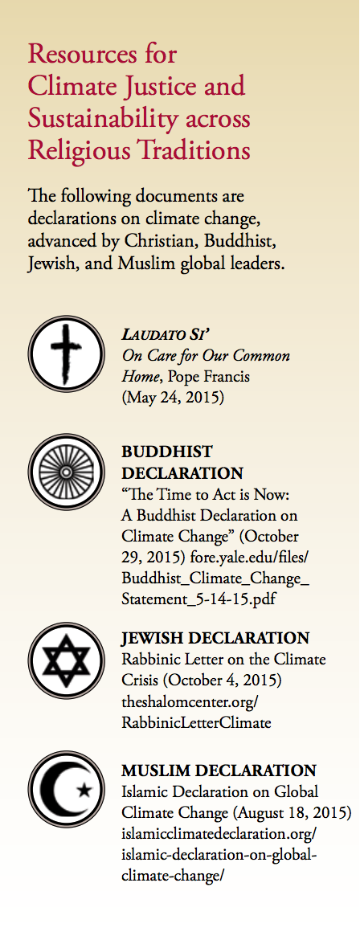
Multifaith Dialogue on Climate Justice: Principles and Practices across Traditions
Excerpt from Multifaith Dialogue, “Our Future on a Shared Planet” Conference, Santa Clara University1
Rev. Sally Bingham, Founder and President, Interfaith Power and Light (dialogue facilitator)
Rabbi Allan Berkowitz, Executive Director, Environmental Volunteers
Linda Cutts, Central Abbess, San Francisco Zen Center, Green Gulch Farm
Ameena Jandali, Founding Member and Content Director, Islamic Network Group
Cardinal Peter Turkson, President, Pontifical Council for Justice and Peace
Cardinal Turkson:
It’s a great honor always to be here at this University. Where else could we be discussing this encyclical? From a Jesuit pope, it can best be discussed at a Jesuit university! As you know, when Jorge Bergoglio was chosen, elected as the pope at the conclave, Cardinal Hummes was sitting next to him and leaned over, trying to encourage him, he whispered to him, “Do not forget the poor.” With that suggestion, Bergoglio took the name “Francis.” So Pope Francis is not just a name; it’s a program; a program of a pontificate, a program of action, and a program of life, and that’s what it’s been. Laudato Si’ is to a large extent inspired by this.
The name Laudato Si’ is taken from the Hymn of St. Francis about creation. Laudato Si’ is “May you be praised, O Lord for Mother Earth. May you be praised, O Lord for Brother Sun. May you be praised, O Lord for Sister Moon,” and so on. So in this particular case, the praise that Francis authors is for Mother Earth, and as the pope says, because Mother Earth is crying and is crying loud for abuses that it has suffered, but Mother Earth is not crying alone. Mother Earth is also crying with the poor who inhabit the Earth, and so the two are crying because, as the pope discussed, there are two fragilities, two vulnerable elements in our creation: the Earth and the poor among us.
But for all of this, the encyclical is therefore not just a simple social document or even still less a scientific document. It’s a document that inspires prayerful contemplation of the universe. There’s a lot of prayer, there’s a lot of meditation in the encyclical. It begins that way and it concludes that way, and on this act then of prayerful contemplation, the encyclical is presented as a gift. The Pope’s argument for inviting concern and respect for the earth is essential because the Earth is a gift, a gift of God to humanity, and what you do with that gift is you are grateful.

You express appreciation and gratitude for it, and that takes the form of prayer, contemplation, and celebration. Because the Earth is so with the poor among us, the pope invites that we also imitate God who gave this to us as a gift. And so we too must gift, if you will, the Earth to other people. Therefore in the light of that the pope analyzes the various abuses of the earth, and that’s where he appeals also to science. Scientific research points to this global warming, climate change, and abusive treatment of the Earth.
So the pope calls for conversion which resonates with the life of St. Francis, the saint of conversion. Francis’ life is a life of conversion, conversion to see God in everything around us, creation, and the poor, and that’s also what inspires Pope Francis. In the life of conversion is an invitation to ecological conversion first used by Pope John Paul II, but ecological conversion and a training in ecological citizenship. All of us must become sensitive to ecology, to how we can preserve the Earth, how we can protect it. What kind of world would we want to leave to those who come after us? Having received the Earth as a garden, we don’t pass it on as a wilderness—or still less, a desert.
Reverend Bingham:
As Cardinal Turkson said, Pope Francis links the cry of the Earth to the cry of the poor and casts these expressions within the same underlying dynamic: “The human environment and the natural environment deteriorate together” (§48).
So we cannot really help one without helping the other. I’m curious about the recent declarations that have come out from the Islamic tradition, from the Jewish tradition, the Rabbinic Letter on the Climate Crisis, and the Buddhists as well have a statement on climate change. Rabbi Berkowitz, let me ask you, how does the Rabbinic Letter on the Climate Crisis connect to the fact that the poor suffer drastically more than wealthy people and countries? Could you tell us a bit about how the rabbis came together to do a statement on climate change?
Rabbi Berkowitz:
The last part of your question, why rabbis came together is the same reason that we’re coming together today, because the Earth is crying out, continuing to cry out. So the rabbinic letter says we urge those focusing on social justice to address climate change, and those focusing on climate change to address social justice, and I see it as an appeal to two caring communities who share a commitment or commitments that align, and the opportunity for these two communities who wouldn’t necessarily on their own think to align with the other community. I see it as a call for these two communities to broaden the tent of caring and activism.
If we go a little bit deeper I would turn to shemitah, the sabbatical year, as the example and teacher. The sabbatical year, which just ended, is a ready resource to understand the Earth–human connection. As we know the sabbatical year has two sides. It has the land side and the human side. Regarding the land, we’re commanded to release it from subjugation, to let it lie fallow. Regarding humans, we’re taught by the Torah to release the impoverished by relinquishing debts, remission of debts, release of ownership and privatization of our land, allowing anybody who wanders by to harvest that which grows freely during that year.
For me, shemitah—and I think this is the spirit behind the rabbinic letter—forces the question: Who or what is really being released? Is the land being released from being overworked, or it is us from the naïve belief that we actually can control and own nature? Who or what is being released? Those who are in debt and are hungry? Or is it a release of our own hearts that sometimes think we can ignore human suffering? So I think in these ways the rabbinic letter and Laudato Si’ perfectly align, and I think those are some of the themes and the spirit behind the rabbinic letter.

(Left to right) Ameena Jandali, Linda Cutts, Cardinal Peter Turkson, Rabbi Allan Berkowitz, and Rev. Sally Bingham enter into dialogue around the ways in which diverse communities can and are mobilizing around issues of climate justice at the multifaith dialogue panel at the “Our Future on a Shared Planet” Conference at Santa Clara University. Photo courtesy of Joanne Lee.
Reverend Bingham:
Ameena, with the Islamic Declaration on Global Climate Change, which came out really quite recently—in fact, since the pope has visited the United States—can you enlighten us on why that has happened? Who are the folks that put this declaration forward and who wrote it?
Ameena Jandali:
A group of scholars and activists worked together to bring the Islamic voice to the table, which has I must say been fairly new and absent for some period of time, despite the fact that Islamic history does have a long tradition of environmentalism with regard to water. There’s actually very detailed descriptions of how to conserve water and how to use water in a way that is renewable in the Qur’an. And though there are many Qur’anic and prophetic sayings, I want to just mention a couple of the applicable pieces from the declaration. “We have no right to oppress the rest of creation or cause it harm; intelligence and conscience behoove us, as our faith commands, to treat all things with care and awe (taqwa) of their Creator, compassion (rahmah), and utmost good (ihsan).”2
Lastly the Qur’anic verse that reads: “There is no animal on the Earth, or any bird that wings its flight, but is a community like you” (Qur’an 6: 38). This reflects as well some of the prophetic narratives about the good treatment of insects. The Prophet forbade some of his companions from destroying anthills. He praised highly a woman who brought water to a thirsty dog and condemned a woman who tied up her cat, not allowing the cat to eat.
So this very clearly demonstrates that creation is not just human beings but all creatures, and obviously the poor and those who are disenfranchised, whether we’re talking about people in Richmond, California, who are getting the fumes from the Chevron refinery, while those of us in the hills can just look down on Richmond and breathe the fresh air. Or entire countries like Bangladesh that are suffering very, very destructive effects from climate change, some of which are threatening to wipe some of these countries off the Earth.
Certainly these are some of the poorest countries, that in the most egregious injustice, contributed the least to climate change. And so we see this locally and we see this globally. Reflecting that, again, reading from the declaration: “Recognize the moral obligation to reduce consumption so that the poor may benefit from what is left of the Earth’s nonrenewable resources.”3
Reverend Bingham:
And Linda, does the Buddhist Declaration on Climate Change have in it an understanding of the relationship between the exploitation of humanity and the exploitation of the earth?
Linda Cutts:
The Buddhist climate change statement to world leaders came out [in] October 2015, and it is signed by His Holiness the Dalai Lama as well as Zen Master Thich Nhat Hanh and a number of other teachers of different schools of Buddhism, and it is being sent around to many, many people. The main point it mentions is the Buddhist realization of what is called dependent co-rising, or interdependence with one another. So the consequences of our actions are critical, and it mentions the beings that have least contributed to our situation are bearing the brunt of it. This teaching of inter-being or interdependence is that we are not separate beings, those beings who are suffering. We owe it to them. The core teaching is that we are to live for the benefit of all beings. Altruism, you might say. The word “altruism” comes from the others, thinking of the others, always as actually bringing happiness to ourselves, compassion. So it does mention that: “We believe it is imperative that the global Buddhist community recognizes both our dependence on one another as well as on our natural world. Together humanity must act on the root causes of this environmental crisis.”4

The desire for things outside ourselves is often where we try to find happiness and contentment and peace. There’s a vow, which says, “Desires are inexhaustible. I vow to put an end to them.” There’s been a lack of understanding that desires are inexhaustible. If you try to fulfill those desires it just causes more desires. It’s like drinking saltwater and becoming more thirsty.
Trying to fill ourselves from external sources is impossible and leads to more and more consumption and more and more unhappiness, discontent, and also to the breaking of our own precepts of not killing, not taking what is not given. So this to me seems so core: How do we find real contentment and real peace? We have to deal with this well or it won’t make a difference.
Rev. Sally Bingham is an Episcopal priest in the Diocese of California, and the founder and president of Interfaith Power and Light. She is one of the first religious leaders to recognize climate change as a moral issue and has been awarded the Audubon Society’s Rachel Carson Award.
Rabbi Allan Berkowitz is the executive director of Environmental Volunteers, a nonprofit organization located in the Palo Alto Baylands Nature Preserve. He was ordained in 1985 at the Jewish Theological Seminary in New York.
Ameena Jandali is a founding member and content director of the Islamic Network Group (ING). She received her M.A. in Near Eastern studies from the University of California, Berkeley, and B.A. in history from the University of Illinois.
Linda Cutts is the central abbess of the San Francisco Zen Center and lives at the Green Gulch Farm Zen Center campus, a meditation and conference center as well as an organic farm and garden.
Cardinal Peter Turkson is president of the Pontifical Council for Justice and Peace, archbishop emeritus of Cape Coast, Ghana. He served in several positions of leadership within the Episcopal Conference of West Africa and as Chairman of the Ghana Chapter of the Conference of Religions for Peace before being appointed to his current post in Rome.
Notes
- “Multifaith Dialogue on Climate Justice,” Our Future on a Shared Planet: Silicon Valley in Conversation with the Environmental Teachings of Pope Francis conference, 3 November 2015, Santa Clara University.
- “Islamic Declaration on Global Climate Change,” (18 August 2015), available at islamicclimatedeclaration. org/islamic-declaration-on-global-climate-change/, accessed 1 November 2015.
- Ibid.
- “The Time to Act is Now: A Buddhist Declaration on Climate Change,” (October 29, 2015), available at fore.yale.edu/files/Buddhist_Climate_Change_ Statement_5-14-15.pdf, accessed 1 November 2015.
Photo Credit:
Earth painting - Liora Davis, “Wake UP! Save the Earth!” mixed media, © 2005. Used with permission. www.lioraart.com
| Previous: Leadership Ethics and Laudato Si' | Home | Next: 2015-2016 Bannan Institute Lecture Series |